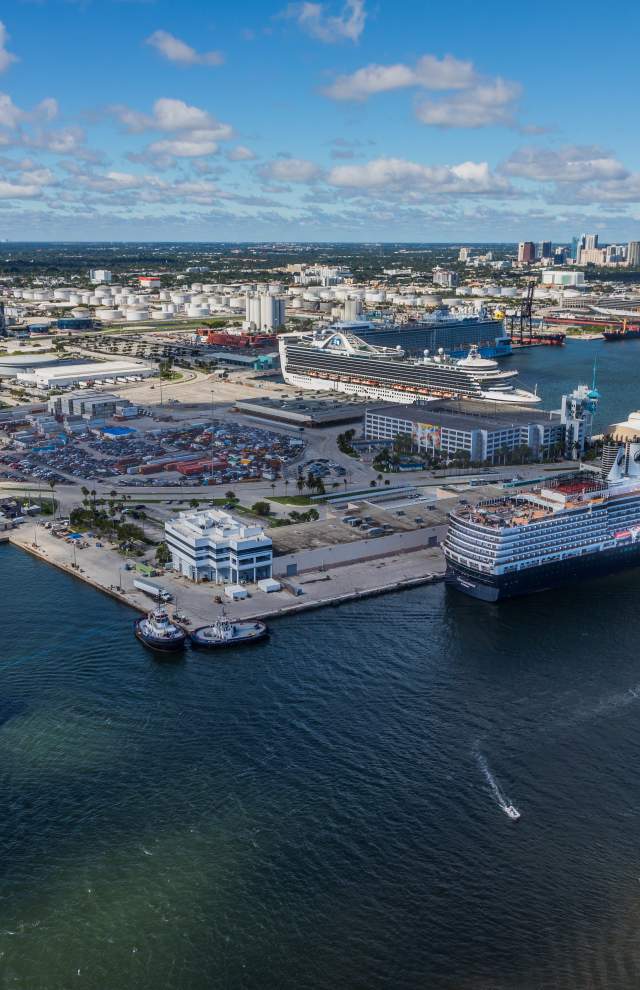Liquefied Natural Gas (LNG)
According to Cruise Lines International Association (CLIA), more ship engines are being outfitted to use Liquefied Natural Gas (LNG), which is a fuel that can reduce emissions from ships. Fuels, including natural gas, are flammable and regulated by various federal agencies. Additionally, the United States Coast Guard has regulatory authority over the transportation and transfer of LNG at the port with support from other public safety professionals at Port Everglades.
What is LNG?
Liquefied Natural Gas (LNG) is natural gas cooled to a liquid state of -260° Fahrenheit. Prior to liquefaction, it is the same natural gas used in homes, businesses, and public buildings to fuel water heaters, stoves, and other appliances. When cooled, natural gas is reduced in volume 600 to 1 and stored in cryogenic tanks.
How is LNG used?
In the transportation industry, LNG is used as a fuel in high horsepower engines and shipped worldwide as an energy source for electrical power generation.
How does it help our environment?
According to Cruise Lines International Association (CLIA), LNG is the leading fuel of the next generation of clean energy for cruise and cargo ships to reduce air emissions. CLIA reports that 48% of new-build cruise ship capacity will be designed with LNG engines and fuel supply systems. Based on analyses by SEA-LNG and others, LNG has virtually zero sulfur emissions and particulate emissions, it reduces nitrous oxide emissions by approximately 85%, and achieves up to a 20% reduction in greenhouse gas emissions compared to fuels currently used in ocean-going vessels.
Who regulates LNG?
Throughout the supply chain, several agencies exercise regulatory oversight of the production, transportation, and transfer of LNG. The U.S. Coast Guard is the lead maritime authority in the United States with oversight of the design and construction standards of the ships that consume LNG as a fuel and transport LNG as a cargo. In addition, the U.S. Coast Guard developed training standards for the seafarers who serve on these ships and created the operational standards and emergency response guidelines to transport and transfer the fuel.
How has the port prepared for LNG bunkering?
In anticipation for LNG bunkering, or fueling, the port and associated governmental agencies studied best practices in ports where LNG is already in use. The port established a franchise application process to evaluate prospective bunkering companies. To determine the measures necessary to safely conduct LNG bunkering, a Hazard Incident (HAZID) assessment was conducted with the U.S. Coast Guard, Broward Sheriff Fire Rescue, the Port Everglades Pilots Association and port representatives. These risk assessments are required by U.S. Coast Guard guidelines before LNG bunkering can occur and were facilitated by American Bureau of Shipping.
In addition, Broward Sheriff Fire Rescue firefighters attended first-responder training at Texas A&M Engineering Extension Service, a leader in emergency response instruction, to enhance their knowledge of the fuel and learn tactics and techniques for emergency response. The firefighters also observed a cruise ship receiving LNG, conducted a site visit of an LNG facility and toured an LNG bunker vessel that operates in multiple Florida ports.
Is LNG new to Port Everglades?
No. Since 2016, exporters under federal approval and oversight have been shipping LNG containers to the Caribbean through Port Everglades. These shipments originate from a permitted LNG liquefaction plant in Medley, Fla., and are transported in special containers. LNG bunkering is new to Port Everglades, although it is commonly practiced worldwide and, in the U.S., including at three other Florida ports: Jacksonville Port Authority, Port Canaveral and PortMiami. According to the coalition SEA-LNG, there are about 230 LNG-fueled ships in operation around the globe. Port Everglades anticipates multiple cruise and cargo ships will request LNG bunkering starting in Spring 2024.
How is LNG transferred to a ship?
Prior to the delivery of LNG fuel to a ship, the franchise holder coordinates its intent to bunker with the U.S. Coast Guard, as required by regulation, along with designated port officials. On the day of delivery, the bunker vessel will maneuver to the outboard side of the receiving vessel and moor. Once safely moored, the bunker process will commence, including a test of the transfer equipment before fueling. Based on the ship’s fuel requirement, the bunker transfer will take about six to eight hours to complete. All transfer operations will occur with the existing U.S. Coast Guard waterside Security Zone and will be monitored by the U.S. Coast Guard, Broward Sheriff’s Office and port staff.

Sources: U.S. Department of Energy’s Fossil Energy and Carbon Management, U.S. Energy Information Administration, Cruise Lines International Association, SEA-LNG, and Just Energy.
